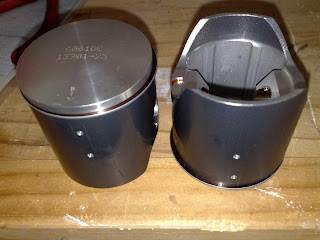Engine modification summary
Note: this is to be a road and track day bike that will run on unleaded 95 octane.
1) Crankshaft aligned to within 0.01mm tolerance
2) Flowed rear upper crankcase and added material to get TDC crankcase volume equal (593ml).
3) Cleaned up transfer port lip edges on barrels to give better flow.
4) Installed 15% lighter Wossner pistons (for 2003 RM125) with 2 holes for exhaust port bridge cooling/lube.
4a) With deck height of RM125 pistons being 0.6mm less than standard, this effectively lifts all ports by 0.6mm or 2.4 degrees at top of exhaust port.
5) Machined heads for 0.8mm squish and 12.8ml combustion chamber volume. Standard is 1.1mm and 13.3ml
6) Installed Mototassinari V-Force III reed blocks.
All bearings, seals, gaskets, and O-rings have been replaced with the exception of the main dry clutch seal.
Most of the visible engine components have been bead blasted with fine grade bead to make them look new-ish.
Yet to be done:
Air box modifications.
Carburetor modifications.
A decent set of expansion chambers and mufflers.
Possibly modify the ignition and/or power valve timing.
Things that could be improved:
1) The main plastic gear for the water pump drive has cracks in it.
2) The lightening holes in the Wossner pistons may not be optimal in terms of flow/harmonics?
Horsepower gained
Well it is impossible to know, but it is fun to optimistically speculate.
Lets start off by assuming that a standard MC18 R5k has 60HP at the rear wheel (RWHP)
Now lets pluck some wildly optimistic numbers out of thin air :-)
Good crank alignment: +0 RWHP
Crankcase flow and volume balance: +3 RWHP (dreamin')
Transfer port clean up: +0.5 RWHP
Wossner pistons. Lighter and ports effectively raised: +2 RWHP
Squish and combustion volume: +4 RWHP
V-Force III reed blocks: +4HP (dreamin')
Dry Clutch on SP model R6k: +1.5 RWHP
Decent set of pipes and mufflers. Haven't got any so: +0 RWHP
This gives an improvement of 15 RWHP taking it to 75 HP at the rear wheel. Total bollocks!
Ah well, dreams are free.
I will get it on the dyno one day, but until then, it's all bollocks.
Realistically, if I can get 65HP at the rear wheel with standard pipes I will be pretty happy.


























